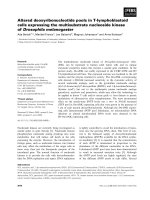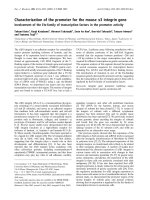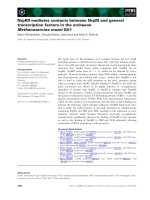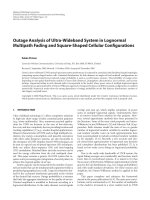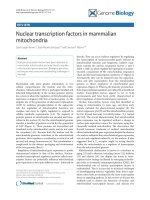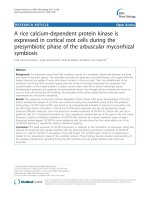Analysis of transcription factors in living human cells with the help of split ubiquitin system
Bạn đang xem bản rút gọn của tài liệu. Xem và tải ngay bản đầy đủ của tài liệu tại đây (2.23 MB, 124 trang )
ANALYSIS OF TRANSCRIPTION FACTORS IN LIVING HUMAN
CELLS WITH THE HELP OF SPLIT-UBIQUITIN SYSTEM
RASHMI TRIPATHI
B.Sc (Honors) Microbiology, University of Delhi
THESIS SUBMITTED FOR THE DEGREE OF MASTERS
DEPARTMENT OF MICROBIOLOGY
NATIONAL UNIVERSITY OF SINGAPORE
2005
ACKNOWLEDGEMENTS
I would like to express my gratitude towards Dr. Norbert Lehming, my
supervisor, for the astute guidance provided during the planning and execution
stages of all the experiments. He has been instrumental in enabling me to
pursue independent work and provided me with the flexibility to try out new
ideas. His support has been invaluable during the course of this research.
I would also like to thank Yee Sun for introducing me to the science of tissue
culture, her initial help in priming me to handle cell lines proved to be
invaluable. Her companionship during all these years has been a memorable
experience for me.
I have obtained excellent technical support from Madam Chew, Wee Leng,
Foo Chee and Cecilia. They have ensured a very smooth running of the lab
and have always been more than willing to share their expertise in handling
new experimental situations.
I would like to thank Elicia, Hong Peng, Jin, Linh, Shin and Vivian for their
encouragement, friendliness and camaraderie.
Last but not the least, I would like to express keen appreciation towards my
family for the strength to carry on through the ups and downs and the
unconditional love and support offered in times most needed. They have
always inspired me to strive towards the best in life.
2
TABLE OF CONTENTS
1
Acknowledgements
2
Table of Contents
3-6
List of Figures
7-9
List of Tables
10
List of Abbreviations
11-12
Measurement Units
13
Summary
14-15
CHAPTER ONE: INTRODUCTION
16
1.1 Aims and Objectives
17
1.2 Gene Expression in Humans: Mechanisms of
18
Transcription
1.2.1. Transcriptional Regulatory DNA Sequences
19
1.2.2. Gene Specific Activation and Repression
23
1.2.3. RNA Polymerase II and the Basic
25
Transcriptional Apparatus
1.2.4. Histones : DNA Packaging Proteins
27
Regulating Transcription
1.2.5. Human Histone Variants: Adding
32
Complexity to Transcriptional Regulation
1.2.6. Linker Histone: Forming Higher Order
37
Structure and Fine Tuning Chromatin Dynamics
1.3. Protein-Protein Interactions and Transcriptional
38
Networks
3
1.3.1. Current Technologies for Screeening
43
Human Protein-Protein Interactions
1.3.1.1. Mass Spectrometry
43
1.3.1.2. Yeast Two-Hybrid System
45
1.3.1.3 Critical Analysis of Yeast-Two-Hybrid
46
Assay and Mass Spectrometry as High Throughput
Tools
1.3.1.4. Protein Chips: Automated Screening
1.3.2. Capturing Protein-Protein Interactions
47
50
Inside Living Human Cells: In Vivo Assays
1.3.2.1. Fluorescence Based Interaction
50
Assays
1.3.2.2. Cell-Signalling Based Interaction
51
Assays
1.4. Split-Ubiquitin System: A Unique Interaction
52
Assay for Transcriptional Proteins
2
CHAPTER TWO: MATERIALS AND METHODS
56
2.1. Testing Interactions Between Linker Histone and 57
Core Histone Proteins inside Human Cells using the
Split-Ubiquitin System
2.1.1. Cloning
57
2.1.1.1. PCR, Restriction and Ligation
57
2.1.1.2. Transformation of DH5 cells
58
2.1.1.3. Miniprep
59
4
2.1.1.4. Checking for Positive Clones
62
2.1.1.5. DNA Sequencing
62
2.1.2. Cloning into pCMV-myc Plasmid
64
2.1.3. Plasmid Purification using QIAfilter Plasmid
65
Midi Kit
2.1.4. Cell Lines and Transfections
2.1.4.1. Construction of Cell Lines Expressing
67
68
hH1-CubRGpt2
2.1.4.2. Co-expression of Nub Constructs with
69
hH1-CubRGpt2
2.1.5. Western-blot
70
2.1.6. Co-immunoprecipitation
71
2.1.7. Molecular Modeling
73
2.2. Using AAV Particles for Protein-Protein
73
Interaction Screening
2.2.1. Cloning
73
2.2.2. Cell Line and Transfection
74
2.2.3. Viral Stock Production
77
2.2.4. Viral infection
77
2.2.5. Fluorescence Activated Cell Sorting
78
2.2.6. PCR and Sequencing of Stably Integrated
78
Viral DNA
3
CHAPTER THREE: ANALYSIS OF PROTEIN-
81
PROTEIN INTERACTIONS BETWEEN THE
5
LINKER HISTONE AND THE CORE HISTONES
USING THE SPLIT-UBIQUITIN SYSTEM
4
3.1. Theory
82
3.2. Results
84
3.3. Discussion
96
3.4. Conclusion
100
3.5. Future Work
100
CHAPTER FOUR: USING AAV PARTICLES FOR
102
SCREENING PROTEIN-PROTEIN INTERACTIONS
INSIDE LIVING HUMAN CELLS
5
4.1. Theory
103
4.2. Results
108
4.3. Discussion
113
4.4. Conclusion
118
4.5. Future Work
118
BIBLIOGRAPHY
120
6
LIST OF FIGURES
CHAPTER ONE
1.1.
Steps in chromatin assembly
21
1.2.
Promoter architecture in yeast and mammals.
22
1.3.
Regulating nucleosomal mobility.
24
1.4.
A model for transcriptional initiation involving RNA
26
polymerase II holoenzyme complex.
1.5.
Nucleosome core particle).
28
1.6.
Annotation map of known histone modifications on
30
the surface of the X. laevis nucleosomal core
particle.
1.7.
Human histone gene clusters spread over seven
34
human chromosomes.
1.8.
Known histone variants and their functions.
1.9.
35
40
Modular Nature of Protein Complexes.
1.10.
Tandem Affinity Purification strategy showing the
48
design of C-terminal and N-terminal TAP tags (left)
and the overall complex.
1.11.
The Yeast Two Hybrid System.
48
1.12.
Design of the Split-Ubiquitin System.
55
CHAPTER TWO
7
2.1.
Map of pcDNA3.1(+) /Zeocin vector
60
2.2.
Map of pcDNA3.1/Neomycin vector
61
2.3.
Map of pCMV-myc Vector used for co-
66
immunoprecipitation
2.4.
Vector Maps of pAAV-IRES-hrGFP, pAAV-RC and
76
pHelper
CHAPTER THREE
3.1.
Phenotype testing and Western-blot analysis of
86
HT1080HPRT- cells expressing hH1-CubRGpt2.
3.2.
hH1 interacts with core histones hH3 and hH4 and
87
not hH2A and hH2B.
3.3.
Western-blot analysis showing in vivo Interaction
90
between linker and core histones hH3 and hH4.
3.4.
Co-immunoprecipitation showing binding of linker
91
histone with core histones hH3 and hH4.
3.5.
Molecular modeling confirms contact of linker
94-95
histone at the dyad axis of symmetry.
CHAPTER FOUR
4.1.
Schematic representation of protocol for screening
111
of protein-protein interactions inside human
HT1080HPRT- cells expressing hH1-CubRGpt2.
4.2.
AAV-293 cells.
114
4.3.
Isolation of genomic DNA from clones.
115
8
4.4.
PCR amplification to detect viral plasmid DNA
115
inserted into genomic DNA.
9
List of Tables
CHAPTER ONE
1.1.
Interaction coverage of protein-protein interactions
42
by species. (Adapted from Bork et al., 2004)
CHAPTER TWO
2.1.
Human histones amplified by PCR from the
63
indicated human cDNA sources.
2.2.
PCR reaction mix per sample.
63
2.3.
Ligation reaction per sample.
63
2.4.
Restriction digests to screen for positive inserts.
63
CHAPTER FOUR
4.1.
Viral titer estimation after infection of
116
HT1080HPRT- cells with pAAV-LacZ stocks.
4.2.
Recovery and selection of cells in 6-TG after
116
FACS.
10
List of Abbreviations
Abbreviation
Extension
AAV
Adeno-Associated Viruses
ATP
Adenosine triphosphate
cAMP
cyclic Adenosine monophosphate
cDNA
complementary Deoxyribonucleic Acid
DMEM
Dulbecco's Modifed Eagle Medium
DNA
Deoxyribonucleic Acid
DNase
Deoxyribonuclease
EDTA
Ethylenediaminetetracetic Acid
FACS
Fluorescence Activated Cell Sorting
FCS
Fetal Calf Serum
FRET
Fluorescence Resonance Energy Transfer
GFP
Green Fluorescent Protein
HA
Hemagglutinin
HAT
Hypoxanthine-Aminopterin-Thymidine
HEK293 Cells
Human Embryonic Kidney 293 Cells
HPRT
Hypoxanthine-guanine Phosphoribosyl Transferase
IRES
Internal Ribosomal Entry Site
LB
Luria-Bertani
MS
Mass Spectrometry
NCBI
National Center for Biotechnology Information
PBS
Phosphate-Buffered Saline
11
PCR
Polymerase Chain Reaction
PMSF
Phenyl Methyl Sulfonyl Fluoride
PS
Penicillin-Streptomycin
PVDF
Polyvinylidene Fluoride
rDNA
Ribosomal Deoxyribonucleic Acid
RGpt2
Guanine phosphoribosyl transferase, with an R (arginine) residue
at the N terminus
RNA
Ribonucleic Acid
SDS PAGE
Sodium Dodecyl Sulphate Polyacrylamide Gel Electrophoresis
TAP
Tandem Affinity Purification
TBST
Tris-Buffered Saline Tween-20
U.V.
Ultraviolet radiation
UBPs
Ubiquitin Specific Proteases
6-His
Six histidines
6-TG
6-thioguanine
Measurements
Extension
12
Units
Nm
Nanometer
Mm
Millimeter
M
Molar concentration
mM
Millimolar concentration
Fmol
Femto mole
G
Grams
Mg
Milligrams
µg
Micrograms
L
Liter
Ml
Milliliter
µl
Microliter
RPM
Rotations Per Minute (Centrifuge Speed)
mA
Milliamperes
13
Summary
Protein-protein interactions are crucial for the formation of complexes involved
in the regulation of transcription. Interactions of the human linker histone hH1
with the other core histone proteins, hH2A, hH2B, hH3 and hH4 have been
analyzed inside human HT1080HPRT- cells with the help of the two-component
split-ubiquitin system. The linker histone regulates the condensation and
decondensation of chromatin by binding to the nucleosomes externally.
However, the position and the orientation of the linker histone with respect to
the nucleosomal histone proteins are still not clear. Studying the interaction of
the linker histone with core histone proteins should yield interesting insights
about its exact location. I have found human histone hH1 to specifically interact
with the human core histone proteins hH3 and hH4. These interactions have
been verified by co-immunoprecipitation in HEK293 cells. Molecular modeling
has helped us to visualize the contact between the linker histone hH1 and hH3
and hH4 in the context of the nucleosome. The split-ubiquitin system is
uniquely suited for screening of transcription factor-binding proteins. It does not
rely on transcriptional readouts for detecting protein-protein interactions unlike
the mammalian two-hybrid system. Moreover, it allows for host cell-specific
post-translational modifications to occur for proteins interacting with histone H1,
which has been chosen as bait in the control and screening experiments
mentioned below.
A high throughput method for screening of interacting partners for human linker
histone inside human cells has also been developed. I have adapted this
system in human HT1080HPRT cells using Adeno-Associated Viral particles
for delivery and expression of a human cDNA library. Dicistronic expression of
GFP from the same plasmid carrying human histones and Prothymosin as a
14
positive control was used to isolate transduced cells with the help of FACS.
Cells with positively interacting bait and prey fusions were selected in medium
containing 6-TG and zeocin based upon conditional degradation of the Gpt2
(guanine phosphoribosyl transferase). The integrated viral DNA can be
recovered from the cells by genomic DNA extraction and PCR. Sequencing of
the purified PCR product reveals the identity of the interacting partner. This
system has a high hit rate as well as a low background for yielding false
positives. This system could be used to screen cDNA libraries in the future.
Identification of linker histone-interacting proteins might yield interesting
insights regarding various regulatory processes that control chromatin
dynamics.
15
CHAPTER ONE
INTRODUCTION
16
1.1.
Aims and Objectives
Protein-protein interactions control cellular organization and dynamics in
diverse biological processes including transcription. Studying transcriptional
initiation and the interplay between the transcription machinery and chromatin
proteins is crucial in our understanding of gene expression during various
stages of development and differentiation of multicellular organisms. The splitubiquitin system was originally devised as a protein interaction assay for yeast
by Johnsson et al. in 1994. It has been adapted for human cells by RojoNiersbach et al. in 2000. This unique in vivo protein interaction assay,
discussed in detail in Section 1.4, offers a novel method to identify interaction
partners for proteins inside living human cells.
The first aim of my Masters project is the characterization of protein-protein
interactions between the linker histone H1, an important player in governing
chromatin structure (Section 1.2.6 and Chapter three), and the core histones
H2A, H2B, H3 and H4 using the split-ubiquitin system. The main objective of
this analysis is to demonstrate the feasibility of the split-ubiquitin system to
detect interactions between human proteins inside human cells and also to
provide answers regarding the nature of the protein interactions between the
linker histone and the core nucleosome.
The second aim of this project is to design a high throughput method based on
the split-ubiquitin system for screening of interacting partners inside human
cells using the linker histone as a bait protein. This novel interaction screening
method could potentially be used with any of the numerous human cellular
17
proteins as baits. It is indeed a challenge to identify the entire set of protein
interactions for human proteins due to the sheer variety of post-translational
modifications, alternative splicing, sequence polymorphisms and the complex
array of cell types with differentially expressed variants for each protein.
1.2
Gene Expression in Humans: Mechanisms of Transcription
Humans have a predicted number of 26,588 genes (Venter et al, 2001).
However in a given cell population only 1-2% of the genes might actually be
expressed. The first step in gene expression is the process of transcription
catalyzed by RNA polymerase. Differences in gene expression govern different
states of differentiation, homeostasis, growth and cell function. All these
functions are achieved by direct transcriptional control of gene expression.
It is envisaged that epigenetics, imposed at the level of DNA-packaging
proteins (histones) might be a critical feature of information storage and
retrieval during embryonic development and differentiation. According to
Jenuwein and Allis, 2001; chromatin structure plays an important role in gene
expression. Histone protein modifications allow regulatable contacts with the
underlying DNA. Many signaling pathways in turn converge on histones. The
enzymes catalyzing their modifications are highly specific for particular amino
acid positions, thereby extending the information content of the genome past
the DNA code.
It is proposed that the formation of distinct higher order
structures such as euchromatin and heterochromatin domains is largely
dependent on the local concentration and combination of modified histones
leading to the formation of different epigenetic states and cell fates.
18
1.2.1. Transcriptional Regulatory DNA Sequences
The basic substrate of the transcription machinery consists of the chromatin
template. The smallest unit of chromatin is the nucleosome, which comprises of
146 base pairs of DNA wrapped around a histone protein octamer complex
(Kornberg, 1977). This fundamental unit of organization has been preserved in
all eukaryotes. The nucleosome provides the first level of organization giving a
packaging ratio of ~6 to the DNA (Lewin, Genes VIII, Pearson Prentice Hall,
2004). The second level of organization is the coiling of nucleosomes into
helical arrays to constitute a 30nm fiber that is found in both interphase
chromatin and mitotic chromosomes and renders a packaging ratio of ~40. The
final packaging ratio is determined by the folding of the 30nm particles upon
themselves to give an overall packaging ratio of ~1,000 in euchromatin and
10,000 for heterochromatin in mitotic chromosomes (See Figure 1.1).
Heterochromatin regions generally have a packaging ratio of 10,000 both
during interphase and mitosis.
Transcription requires unwinding of chromatin for relevant enzyme complexes
and transcription factors to gain access to the DNA. RNA is transcribed from
the DNA template by the RNA polymerase when it binds to a special region on
the DNA called the “promoter” lying at the start of every gene. The promoter
consists of an AT rich sequence, the TATA Box, and sequences bound by
transcriptional regulators (See Figure 1.2). The promoter surrounds the first
base pair that is transcribed called the “transcription start site” from which RNA
19
polymerase moves along the template synthesizing RNA until it reaches the
terminator sequence. This sequence, from the promoter to the terminator,
comprises the transcriptional unit.
In a recent study, 174 new regulatory motifs were identified for humans (Xie et
al., 2005). Using gene expression data from 75 human tissues, significant
enrichment in one or more tissues was seen for 59 of the 69 (86%) known
motifs and 53 of the 105 (50%) new motifs.
The TATA Box is the binding site for the TATA-binding protein (TBP). In some
genes, the transcription initiation site consists of the initiator element (Inr)
defined as an element encompassing the transcription start site that binds
regulatory factors.
Eukaryotes also contain certain regulatory sequences called Upstream
Activating Sequences (UASs) which are bound by activators. Also present are
enhancers which can reside thousands of base pairs upstream of the promoter
elements. Transcriptional enhancers
integrate
positional and
temporal
information to regulate the complex expression of developmentally controlled
genes. Current models suggest that enhancers act as computational devices,
receiving multiple inputs from activators and repressors and resolving them into
a single positive or negative signal that is transmitted to the basal transcription
machinery (Kulkarni and Arnosti, 2003). DNA elements can be also bound by
repressor proteins. These are called Upstream Repressing Sequences or
URSs. Silencers are defined as sequence elements that can repress promoter
activity in an
20
Figure 1.1. Steps in chromatin assembly (Adapted from Ridgway and
Almouzni, 2001)
The basic nucleosome is formed by the assembly of 146bp of DNA wrapped
around a histone octamer complex. Nucleosomal arrays are further folded into
higher order structures by the action of the linker histone.
21
Figure 1.2. Promoter architecture in yeast and mammals. (Reprinted from
Molecular Cell Biology by Harvey Lodish et al. © 1986, 1990, 1995, 2000 by
W. H. Freeman and Company. Used with permission)
Promoter elements of a typical mammalian gene and a S. cerevisiae gene
have been described. These contain the transcription start site, the TATA box,
as well as certain upstream activating sequences (in yeast) and promoter
proximal elements (in mammalian genes). Enhancers can lie hundreds or
thousands of bases upstream of the basic promoter element. The mammalian
promoter consists of many more regulatory elements than the S. cerevisiae
promoter.
22
orientation and position dependent fashion. For example CpG islands have
been implicated in silencing by methylation (Antequera and Bird, 1998).
1.2.2. Gene Specific Activation and Repression
Activation of genes is achieved by the binding of transcriptional activators to
upstream activating sequences. Activators consist of two domains: one is the
DNA binding domain and the other is activating domain which stimulates the
activity of transcriptional apparatus. Transcriptional activators can recruit
chromatin modifying complexes such as the Swi/Snf and SAGA (PCAF) to
promoters (Blanco et al., 1998). The human counterparts of the chromatin
modifying complexes in yeast hBAF (Swi/Snf in yeast) and hPBAF (Rsc in
yeast) have also been described recently (Mohrmann et al., 2005). These
chromatin remodeling factors either utilize energy by ATP hydrolysis (Swi/Snf)
to loosen the contacts between histones proteins and DNA or they acetylate
histones (SAGA), thereby activating genes (See Figure 1.3).
The transcriptional activators can recruit much of the transcriptional apparatus
including RNA polymerase II, general transcription factors in a single or multiple
steps (Greenblatt et al., 1997).
Repressors are equally important and can be classified into general repressors
or gene specific repressors. Many general repressors function via interactions
with TBP. Mot1, for example, represses transcription by binding to TBP and
causing its dissociation in an ATP-dependent manner (Auble et al., 1997).
Histone deacetylases can repress transcription by binding to either DNAbinding
23
Figure 1.3. Regulating nucleosomal mobility. (Reprinted from Nature
Structural and Molecular Biology, Cosgrove et al., 2004, used with
permission)
a) Chromatin is regulated by factors that control the equilibrium between
nucleosomes with low versus high mobility. Proposed intermediates are
shown on the pathway of transcriptional activation and repression,
catalyzed by the concerted action of ATP-dependent nucleosomeremodeling factors (ADNR) and covalent histone-modifying enzymes.
Activation can be achieved by histone modifications that weaken
histone-DNA contacts, such as acetylation by HATs, resulting in
increased nucleosome mobility. Repression is achieved by histone
modifications that restore histone DNA contacts, such as deacetylation
by HDACs, resulting in decreased nucleosome mobility. (b) Uncoupling
regulation of nucleosome mobility by GCN5 or SWI/SNF knockouts
blocks gene expression by preventing the switch from nucleosomes with
low mobility to nucleosomes with high mobility. Mutation of histone-DNA
contacts (SIN mutations) relieves repression in gcn5 and swi/snf strains
by weakening histone-DNA contacts, resulting in increased nucleosome
mobility and access to DNA. Mutations that prevent restoration of
histone-DNA contacts (Lrs mutations) uncouple control of nucleosome
mobility by deacetylation, preventing the switch from nucleosomes with
high mobility to low mobility, resulting in the loss of gene silencing.
24
proteins or by binding to co-repressors like N-cor, SMRT, Rb (Ayer et al.,
1999). Deacetylase activity can be linked to methylated DNA by MeCP2 which
binds to methyl-CpG within the chromatin causing gene silencing (Bird et al.,
2002; Nan et al., 1998; Jones et al., 1998).
1.2.3 RNA Polymerase II and the Basic Transcriptional Apparatus
The assembled initiation apparatus consists of 12 subunits of RNA polymerase
II core enzyme, general transcription factors and one or more complexes called
co-activators or mediators (See Figure 1.4). Genes for the 12 human RNA
polymerase II subunits have been described and they show a lot of homology
with their yeast counterparts. Its various subunits have diverse functions like
start site selection, elongation and interaction with activators.
The largest
subunit of RNA Polymerase II contains a unique carboxyl-terminal repeat
domain (CTD) that consists of tandem repeats of consensus heptapeptide
sequence (Tyr-Ser-Pro-Thr-Ser-Pro-Ser) (Corden et al., 1990). There are 52
such heptapeptide sequences in humans.
The phosphorylation state of CTD determines various stages of transcription.
RNA polymerase II is recruited to the initiation complex in the unphosphorylated
state whereas during elongation it becomes heavily phosphorylated (Dahmus et
al., 1996). CTD can be phosphorylated by many kinases like TFIIH (Feaver et
al., 1991), Srb10/Cdk8 kinase and Kin28 (Holstege et al., 1998). Fcp1 is a CTD
phosphatase which binds to the general transcription factor TFIIF suggesting its
role in RNA polymerase recycling (Chambers et al., 1995 and Cho et al., 1999).
25

